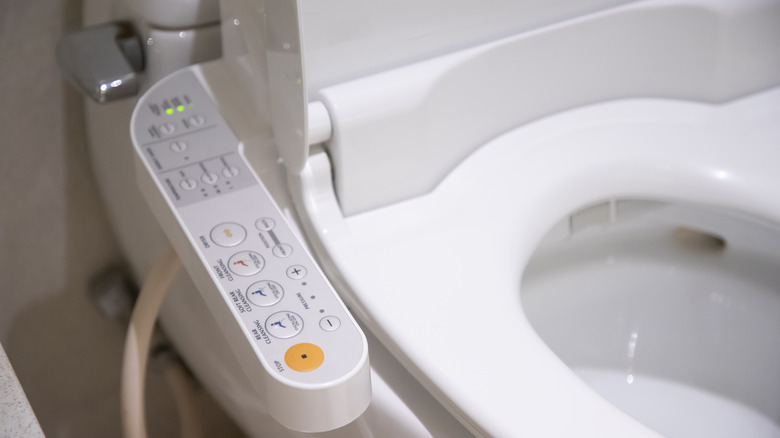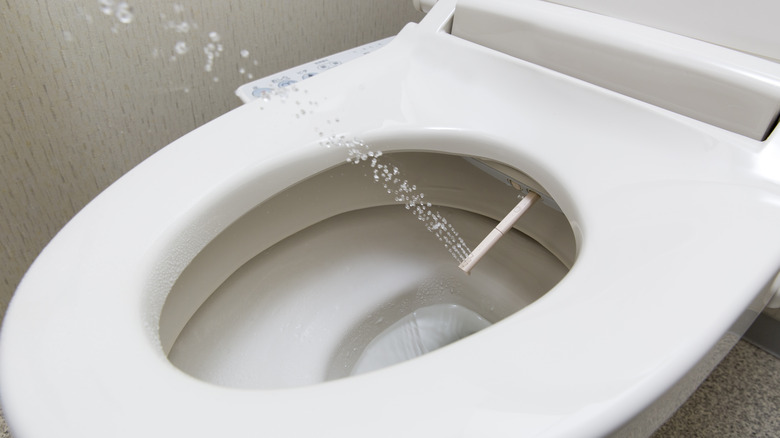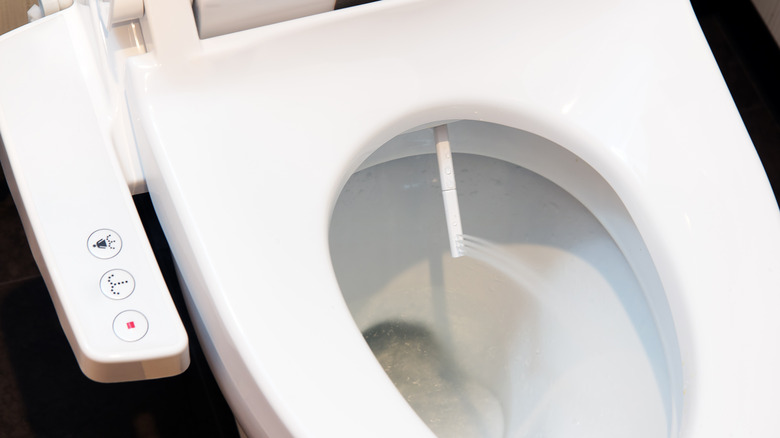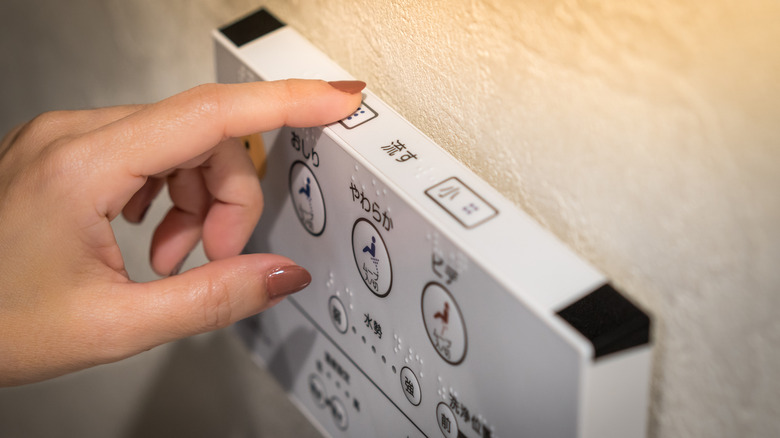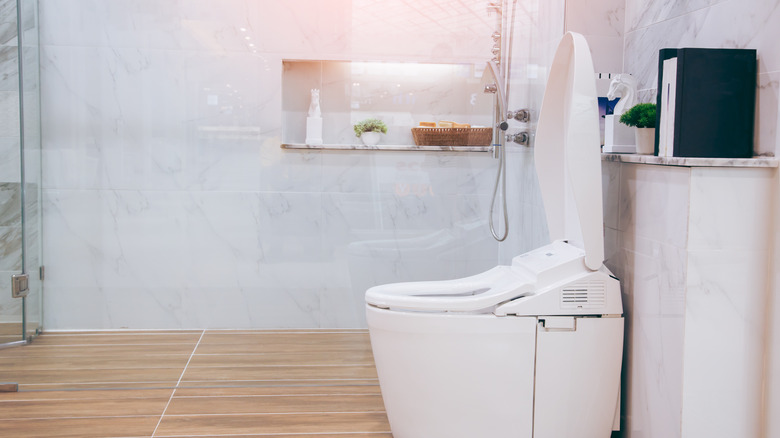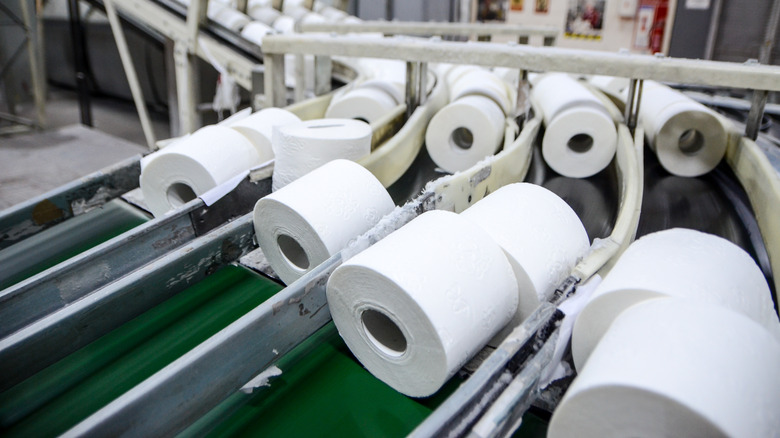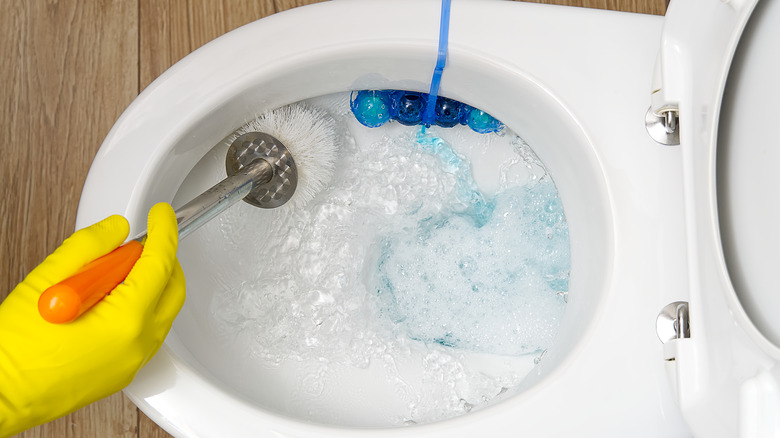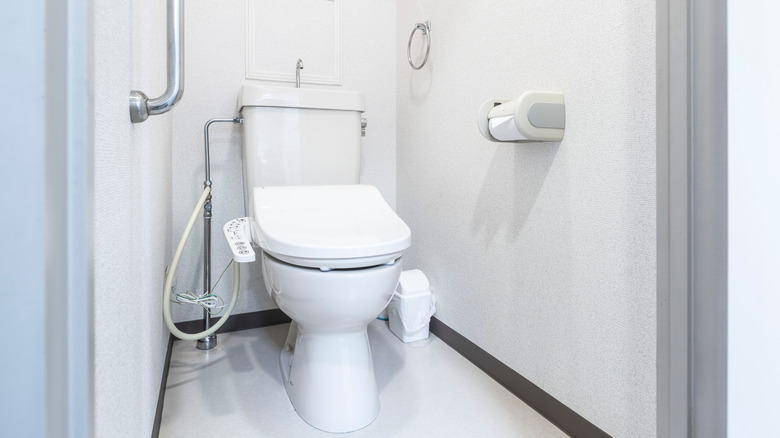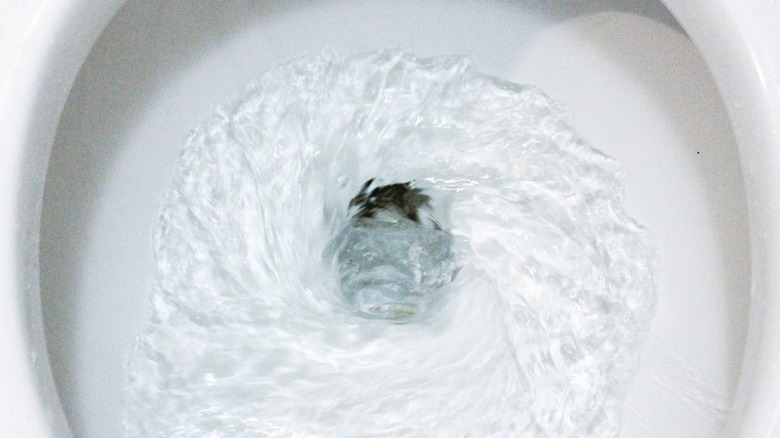What Is A Japanese Toilet And Why Do You Need One?
Unless you've been fortunate enough to visit Japan recently, you may be surprised to learn that Japanese toilets differ significantly from American toilets, and even from toilets in other Western countries, such as European toilets. Japanese toilets accomplish the same basic task as toilets the world over: eliminating your waste in a hygienic, efficient way. But these amazing appliances go above and beyond simple waste disposal. All About Japan reports that Japanese toilets are equipped with a dizzying array of additional features, from multi-stream bidet nozzles to self-cleaning options to music users can elect to play while doing their business.
These fancy, futuristic toilets first rose to prominence in Japan in the 1980s, according to a consumer spending survey conducted by the Japanese government, and by the mid-2010s, over 81% of Japanese households had a toilet with additional flourishes and features. These multifunctional toilets are rapidly spreading around the world — and it's not difficult to see why. Read on to learn more about Japanese toilets and how they can potentially help you step up your bathroom game.
What makes Japanese toilets unique?
A toilet doesn't necessarily need to come from Japan to be considered Japanese. The phrase "Japanese toilets" is used to indicate any toilet with additional features beyond conventional American and European toilets — features that were typically developed and patented in Japan, according to Insider. The defining feature of a Japanese toilet is its bidet, AKA a nozzle that sends water onto a user's nether regions for cleaning purposes. While European toilets have a separate bidet system, and The Atlantic reports American toilets usually lack bidets entirely, Japanese toilets have integrated electronic bidets that often require no additional effort to operate.
These toilets have become so widespread in Japan and other Asian countries that their main manufacturer, the Toto Group, has been able to rebrand the appliances not as toilets, but as "washlets." Washlets have yet to achieve widespread use outside of Asia, but that situation is changing, with washlets becoming known in English-speaking countries as "Super Toilets" and even, as The New York Times puts it, "Toilet Nirvana."
The famous bidets
So what exactly sets a Japanese toilet's bidet apart? It's more than just the simple electronic operation system. Bidets in European countries are entirely separate appliances, per The New York Times, thus requiring the user to move from the toilet to the bidet — and movement around the bathroom is not exactly convenient when your pants are down around your ankles. In contrast, Web Japan explains that Japanese toilets have bidet systems built into the toilet bowl itself, so users can do their business and clean themselves, all without needing to stand up. Most Japanese toilets feature bidets with both a front and back stream — the back one for cleaning up after going number two, and the front one for those of us who need to sit to pee.
Even the most basic of Japanese toilets feature this next-level bidet system, but the sky is really the limit when it comes to how fancy the built-in bidets can get. The Washington Post reports that some bidets even incorporate a mild soap, so you're not just rinsing off, but thoroughly cleansing. With some models, you can control the temperature of the water so it's not such a cold shock to the system. And the really high-end options allow for more variations beyond a steady water stream, such as one that pulsates or oscillates. Never let it be said that the bathroom is no place for innovation!
Additional features of Japanese toilets
The integrated bidet may be the defining feature, but it's really only the tip of the iceberg when it comes to the bells and whistles of Japanese toilets. One feature even more common than the bidet is the heated seat. In the colder, northern region of Japan, heated toilet seats are considered a necessity — not a luxury — and this attitude has spread to the Japanese toilet fan base, according to The Washington Post. The shock of sitting on a cold toilet seat in the morning is so last decade!
Other fancy features, described in the Los Angeles Times, include a blow-dry system (for use after rinsing off with the bidet, of course), air deodorizing, speakers to play music, glow in the dark options, an air-conditioned toilet rim for those hot summer months, and even massagers built into the toilet seat itself. Most Japanese toilets also incorporate a control panel system, sometimes built into a small handheld remote control, for managing all of these attributes.
Automation and proximity sensing
Feeling a little overwhelmed at all these toilets can do? Not to worry — one of their most impressive aspects is how much of their operation is completely automated, so there are very few features you actually have to manage yourself.
The automation starts before you even sit down. The Toto Neorest, a high-tech toilet model commonly found throughout Japan, has an automatic lid that lifts when its proximity sensor determines someone is standing close to the toilet. Some Neorest versions even take it a step further: The toilets will lift only the lid if they sense that someone is facing away from the toilet, e.g. preparing to sit down, but they will lift both the lid and the seat if someone is facing the toilet, e.g. standing to pee. No more worrying about forgetting to put the seat up or down!
Most of these toilets' built-in bidets also have proximity sensors, so the streams will automatically shut off if a user stands up. This automatic shut-off was not part of the original Japanese toilet design, but after a report published by the World Toilet Organization (yes, there is such a thing) found that non-Japanese users were frequently so startled by the bidet that they would stand up quickly and the bidet would subsequently shoot water out into the bathroom, the design was adjusted.
And remember those seat heaters? The Los Angeles Times reports that more and more of these top-of-the-line Japanese toilet models collect and analyze data on when and how often the toilet is used, so the device can automatically warm up the seat during high-use times and shut the warming off during idle periods, saving energy.
Environmental impact of Japanese toilets
The energy-saving automated seat heating isn't the only aspect of Japanese toilets that takes into account sustainability and environmental impact. These toilets are much more environmentally friendly than Western toilets — and keep in mind that making your bathroom more sustainable isn't just benefitting the planet, it can also benefit your wallet. Eco-friendly bathroom design can significantly increase your home's resale value, so investing in a toilet that helps mitigate climate change brings you double bang for your buck.
The secret to the environmental friendliness of Japanese toilets? It all goes back to that bidet. Using a bidet for bathroom hygiene and cleanliness reduces use of a nonrenewable resource: toilet paper. Scientific American reports that Americans sacrifice 15 million trees a year to the creation of almost 37 billion (that's billion with a b!) rolls of toilet paper.
Some of you may be thinking "Wait, but don't bidets use a lot of water? That's not good for the planet either, right?" Not so fast. That same Scientific American report reveals that the process of creating and manufacturing toilet paper actually uses significantly more water than a bidet ever would. You would have to use a bidet 296 times to match the amount of water required to produce a single roll of toilet paper. It's pretty hard to argue with that discrepancy.
Many Japanese toilets take things a step further when it comes to saving water by combining two appliances notorious for consuming (and wasting) water: the toilet and the bathroom sink. Live Japan explains that for some Japanese toilet models, the sink perches atop the toilet tank, so that the water you use to wash your hands flows into the tank and is then used to flush the toilet. Don't worry, it's impossible for the system to malfunction and work in reverse — you would never be in a situation where the water from the toilet flows back up and comes out of the sink faucet! (Another benefit of this setup is the amount of space it saves by combining two bathroom appliances into one, which can be especially beneficial if you have a small bathroom.)
For the mega environmentally conscious among us, it is important to note that a research report commissioned by the Development Bank of Japan found that Japanese toilets do require more energy than typical American toilets (whose energy consumption is nonexistent). Most of the fancy features associated with Japanese toilets need electricity to operate, so their energy consumption does offset their water savings a bit. But still, it's pretty clear that using the Japanese toilet system has much less of a climate impact than that of American toilets.
Cleaning and maintenance of Japanese toilets
All those fancy features must make it pretty complicated to keep Japanese toilets clean, right? Actually, nothing could be further from the truth. Many Japanese toilets have additional features designed to help keep themselves clean, meaning you would probably spend less time cleaning these toilets than you would an American model.
Many Japanese toilets, such as those using Toto's "Premist" method, automatically rinse the toilet bowl before use, reducing the likelihood of anything sticking to the bowl and needing to be scrubbed off later. Some add a little bit of soap into the bowl's water, so that flushing the toilet will distribute the soap around the bowl and clean things up on the way out (soap in the toilet water also has the added benefit of preventing splashing). The most advanced models turn on a UV light after the toilet is used, scouring and disinfecting every inch of the bowl with the light's sanitizing rays.
And don't worry about needing to get all up in there and clean those famous bidets – Wired reports that most bidets employ a self-cleaning mechanism, and since the bidet never actually touches the user, contamination is usually impossible.
Drawbacks of Japanese toilets
Okay, Japanese toilets are pretty cool. But that doesn't mean that there aren't some negative aspects to Toilet Nirvana.
One of the biggest drawbacks of using a Japanese toilet was already mentioned above: They run on electricity, meaning they need to be plugged in. As noted in the Taipei Times, most American bathrooms don't have electronic outlets located near the toilet area, because of safety rules and regulations that require the separation of appliances that use water from appliances that use electricity. Great for preventing electrical shock — not so great for getting yourself a toilet that keeps your backside warm. So if you want one of these toilets in your home, you may need to get a little creative with electrical wiring, or even extension cords.
Another Japanese toilet problem is more medical in nature: The Fujiie Proctology Clinic in Japan reported that an increase in bidet use has led to a spike in what their doctors are calling "Washlet Syndrome." Essentially, when a bidet user is overzealous in cleaning their nether regions, they can eliminate the "good" bacteria in addition to the more unsavory kind, and this change can lead to irritation and skin sensitivity. So make sure that if you do go the bidet route, you keep your enthusiasm in check when it comes to cleaning your back door.
The future of Japanese toilets
What's next for these already-futuristic bathroom appliances? The New York Times reports that the next frontier in toilet technology may be tracking users' health, such as the new WellYouII technology pioneered by Toto, the premier Japanese toilet manufacturer mentioned several times above. WellYouII can measure blood sugar in a user's urine. Other rival high-tech toilet manufacturers such as Panasonic are countering with toilet seats that can measure the pulse, body fat, and blood pressure of their users.
But, there are also innovations with a little less at stake, such as Toto's Mini Unit, which is smaller and more portable than their washlet. According to CNET, Toto is also exploring talking toilets, meaning both toilets that can talk to their users, and toilets that are responsive to voice activation. While that idea may seem a little ridiculous on the surface, you can imagine the possibilities for a public bathroom situation — instead of needing to reach out and push the same flusher that has probably already been touched by hundreds of other people, you could simply tell your toilet "Flush!" and walk away, hearing the hiss of the water behind you. Welcome to the future.
